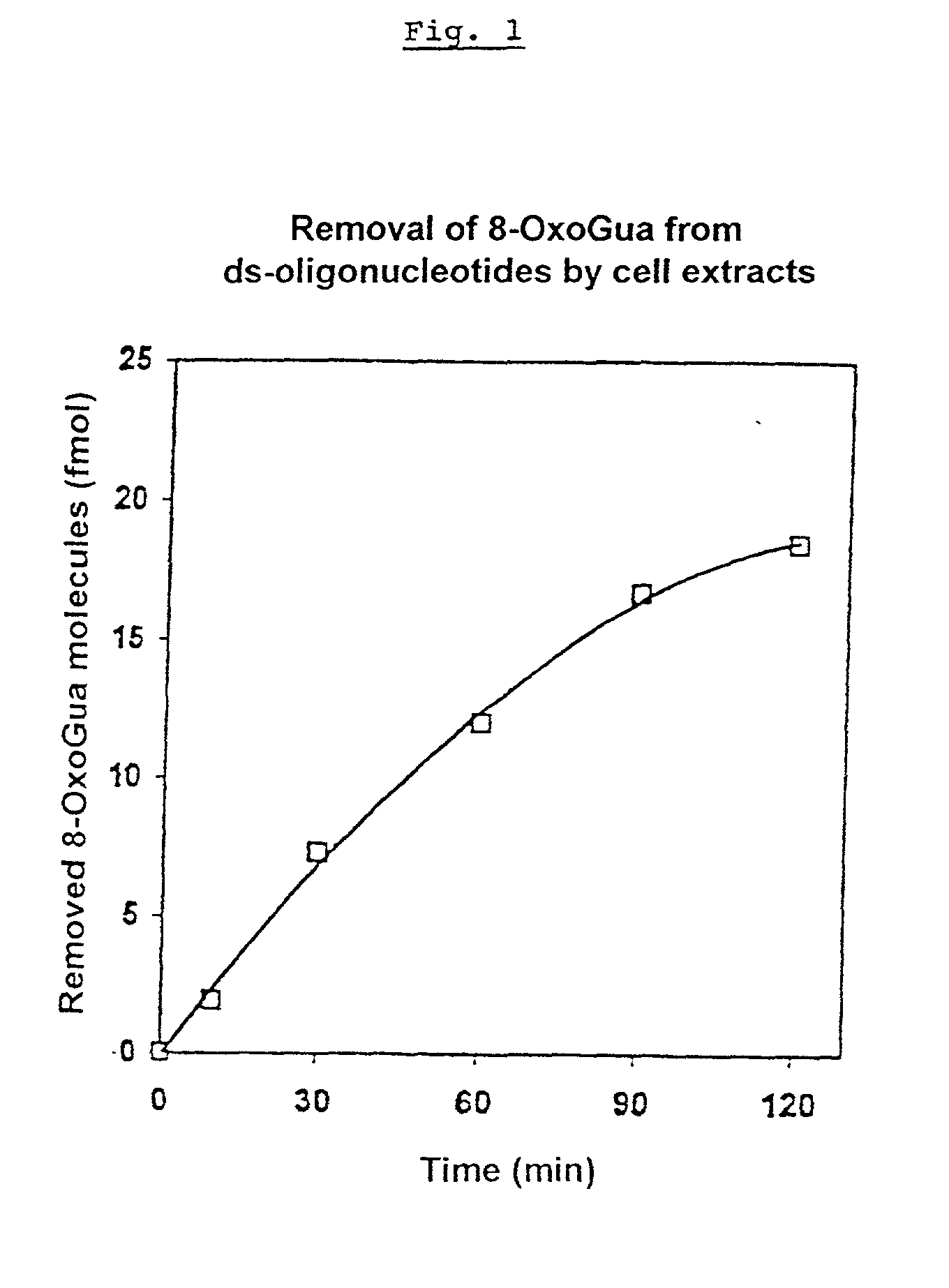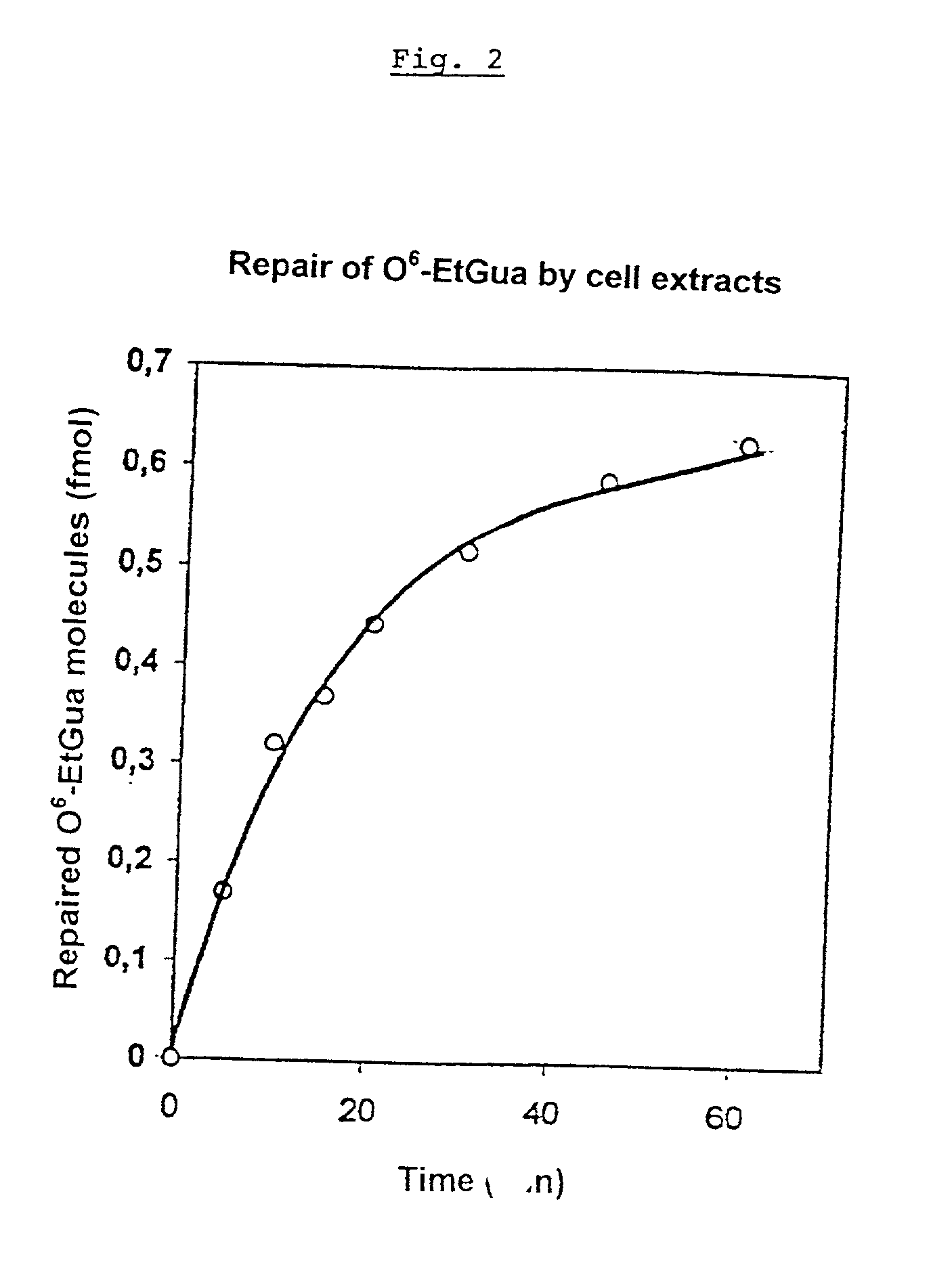Method and test kit for analyzing DNA repair
a dna repair and kit technology, applied in the field of methods and test kits for analyzing dna repair, can solve the problems of loss of sample material during processing, particular time-consuming, labor-intensive and expensive execution, cell death, etc., and achieve the effect of ensuring the susceptibility of this person with respect, quickly and precisely determining the repair capacity of tumor cells
- Summary
- Abstract
- Description
- Claims
- Application Information
AI Technical Summary
Benefits of technology
Problems solved by technology
Method used
Image
Examples
example a
Removal of 8-oxodeoxyguanosine from ds-oligonucleotides
Type of Repair
[0124] Most of the DNA modifications, postreplicative base mispairings and apurinic or apyrimidinic sites are removed from the DNA by excision repair (an enzymatic process). The DNA oxidation product 8-oxoguanine (8-OxoGua) is repaired according to the same mechanistic principle. In humans there are at least two different repair systems which eliminate this base modification from the DNA. In mice, only one of the two repair systems was detected.
[0125] Independent of the mechanism of the 8-OxoGua-excision, a gap having the size of a nucleotide is intermediately formed in the DNA.
Practical Execution of the Test
[0126] For the test, MPs were used in whose wells with flat bottoms ds-oligonucleotides (30.times.10.sup.-15 mol dsDNA-molecules / well) were immobilized, which in position 16 contained the oxidation product 8-OxoGua and in positions 35 and 36 biotinylated uracil.
[0127] The cell extract to be analyzed was prepare...
example b
Dealkylation of O.sup.6-ethylguanine in ds-oligonucleotides
Type of Repair
[0140] The O.sup.6-ethylguanine (O.sup.6-EtGua) formed by alkylating carcinogens is repaired in one step by an O.sup.6-alkylguanine-DNA-alkylt-ransferase (AT). AT transfers an alkyl group from the O.sup.6-position of the guanine to a cysteine in the active center of the protein. By the transfer of the alkyl group, the AT is inactivated. Thus, each AT molecule can always repair only one O.sup.6-EtGua molecule. Accordingly, the repair is effected in a bimolecular reaction.
[0141] The repair can be analyzed by means of antibodies against O.sup.6-ethyldeoxyguanosine. Monoclonal or polyclonal antibodies may be used. Monoclonal antibodies can, for instance, be produced as follows:
[0142] First of all, the synthesis of O.sup.6-ethylriboguanosine and the coupling of the alkylation product to KLH (keyhole limpet haemocyanin) are effected as described by R. Muller and M. F. Rajewsky (Z. Naturforsch., 33c, 897-901, 1978). F...
PUM
| Property | Measurement | Unit |
|---|---|---|
| pH | aaaaa | aaaaa |
| pH | aaaaa | aaaaa |
| pH | aaaaa | aaaaa |
Abstract
Description
Claims
Application Information
 Login to View More
Login to View More - R&D
- Intellectual Property
- Life Sciences
- Materials
- Tech Scout
- Unparalleled Data Quality
- Higher Quality Content
- 60% Fewer Hallucinations
Browse by: Latest US Patents, China's latest patents, Technical Efficacy Thesaurus, Application Domain, Technology Topic, Popular Technical Reports.
© 2025 PatSnap. All rights reserved.Legal|Privacy policy|Modern Slavery Act Transparency Statement|Sitemap|About US| Contact US: help@patsnap.com


